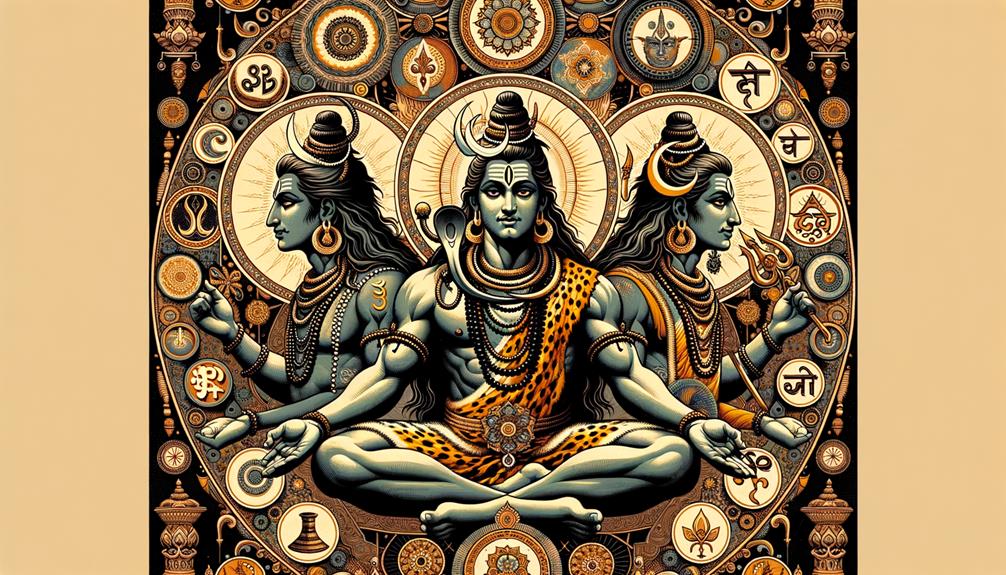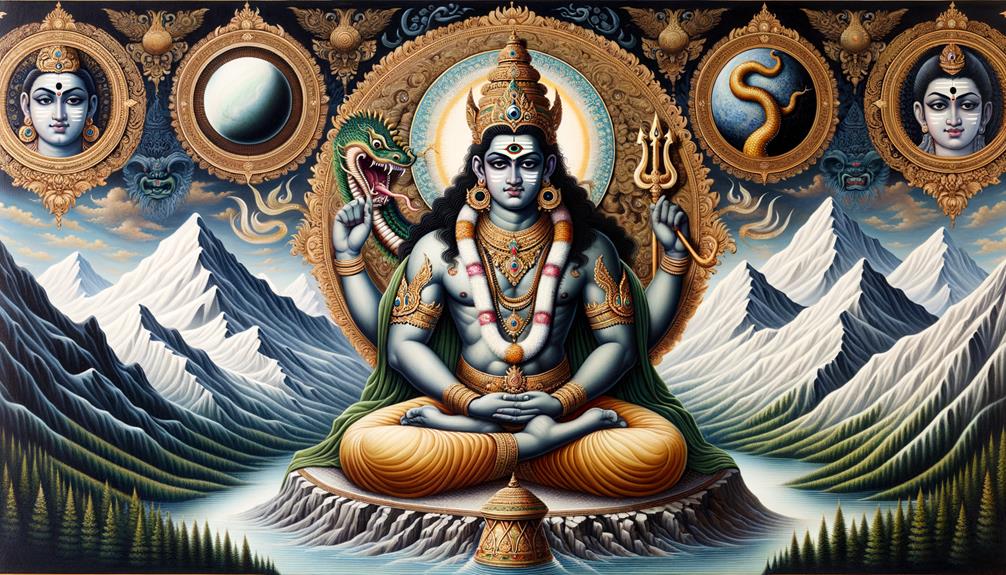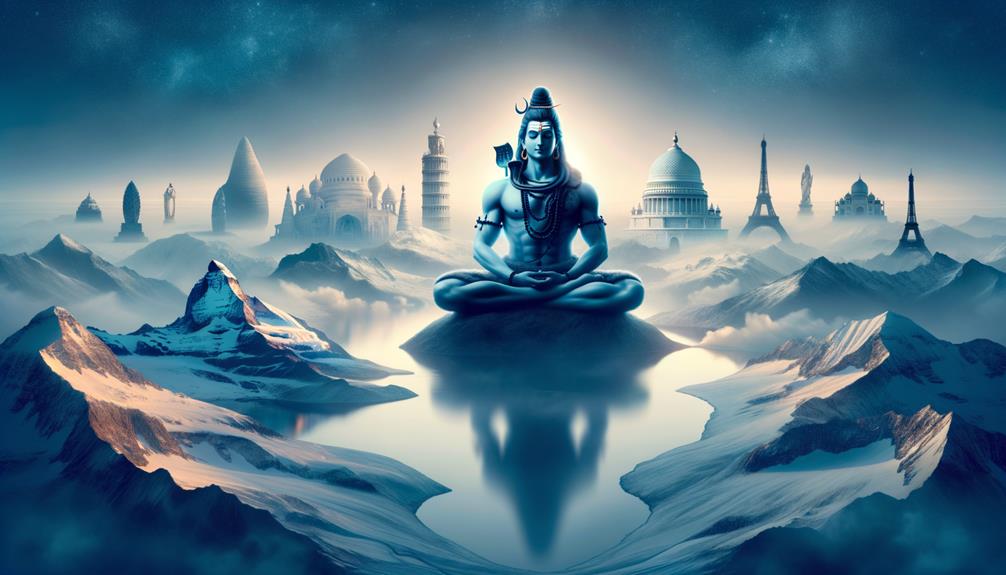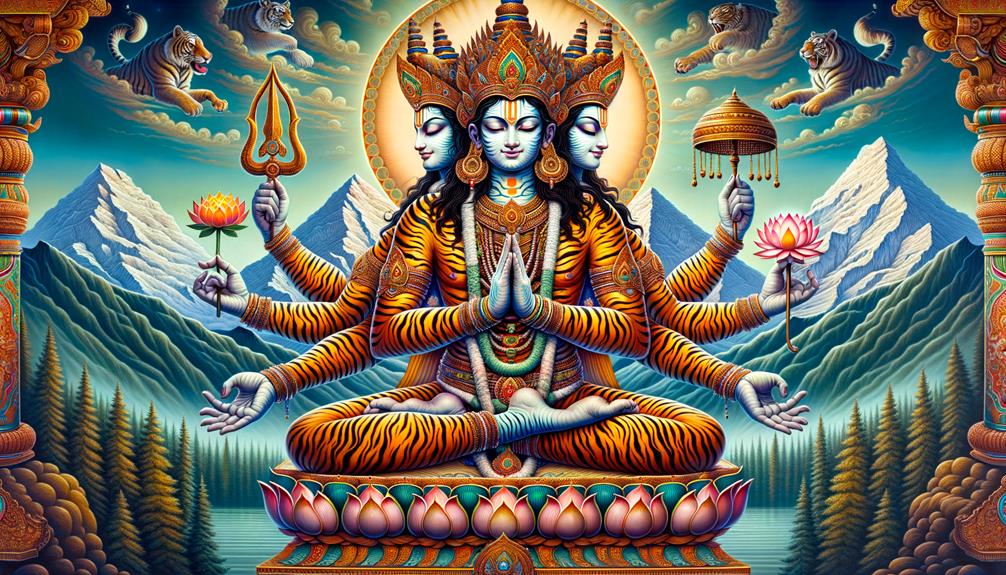Delving into the realm of Hinduism, we find Shiva, a deity who is both peaceful yogi and formidable destroyer. As a researcher, Shiva's multifaceted personality fascinates me. He represents both creation and destruction, the solitary ascetic and the dutiful family man. This makes understanding his divine role a complex but fascinating task.
Shiva isn't only known as the destroyer within the Hindu trinity, but he's also a caring father, an exemplary yogi, and a devoted lover. His symbols range from the calming Ganga river to the lethal trident, adding more depth to his character. This inherent complexity influences how Shiva is worshipped, how his images are created, and the social and cultural contexts he influences.
Let's set out on a journey to peel back these layers. We'll examine history, theology, and cultural practices, and along the way, we'll see why this complexity makes Shiva such an intriguing figure, not just in Hinduism, but also beyond its borders.
Historical Significance of Shiva

Let's look at the historical importance of Shiva. He has a fascinating past that starts from pre-Vedic times and evolves into a blend of different deities adored across India and Southeast Asia. The evolution of Shiva can be seen in the many names and titles he is known by, such as Viswanatha, Mahadeva, Shankara, and Rudra. This represents the wide range of cultural and linguistic influences that have shaped his worship and mythology.
Shiva's identity is quite complex. As one of Hinduism's intricate deities, he shares connections with other gods such as Rudra, Agni, and Indra. These connections are highlighted in Hindu scriptures and Vedic literature, and they show the detailed interconnections within the Hindu pantheon.
Shiva is highly revered in Shaivism, which is one of the four major sects of Hinduism. His position reflects his extensive influence and the variety of traditions within the religion. His portrayal in art, through his varied forms, symbols, and family, underscores the historical importance of Shiva as a crucial cultural and religious symbol in Hinduism.
In short, to grasp the historical importance of Shiva, it helps to examine the rich blend of cultural, linguistic, and religious influences that have shaped Hinduism.
Shiva's Role in Hindu Sects

Let's chat about Shiva's role in the diverse Hindu sects. Shiva is deeply respected and revered, especially in Shaivism. Here, he is considered the principal deity of the Trimurti, signifying his prominent status. But his influence isn't just confined to this sect or region. Shiva's prominence spreads far and wide in Hinduism, marking him as a key figure in the faith.
Shiva, the intricate deity of Hinduism, is seen as a fusion of several older gods. This fusion process involved the incorporation of numerous local cults and gods, resulting in Shiva's multi-dimensional role in Hinduism.
Shiva's complex nature is further emphasized through his various portrayals. He is known as Viswanatha, Mahadeva, Shankara, and Rudra, with each name carrying distinct symbolic meanings. His symbolism also extends to his formless representation as the lingam, his ties with the serpent king Vasuki, the crescent moon, the sacred river Ganga, and the trishula. All these symbolisms enhance his stature as a versatile deity, responsible for both creation and destruction.
Attributes and Depictions of Shiva

Delving into the characteristics and portrayals of Shiva uncovers a captivating array of diversity, reflecting the inherent complexity of this pivotal Hindu deity. Often referred to as 'The Destroyer' in the Hindu triumvirate, Shiva's representations range from an all-knowing Yogi to a family man alongside his spouse Parvati and their offspring. He is also associated with unique elements like the serpent king Vasuki, the crescent moon, the sacred river Ganga, and the trishula or trident, which all contribute to his multifaceted image.
Those devout to Shiva often worship him in the symbolic form of a lingam. His varied manifestations – such as Nataraja, the Lord of Dance, and Ardhanarishvara, the half-man, half-woman, provide a broader perspective of Shiva's diverse character. Symbols like the trident, serpent, crescent moon, drum, and ashes enhance the rich array of Shiva's characteristics and depictions.
Shiva, the destroyer, is not merely a symbol of annihilation, but also of rebirth and transcendence, giving him a depth that exceeds standard divine classifications. This examination reveals the multifaceted layers that make Shiva not only a fundamental part of Hinduism, but also a compelling topic within the study of religion and mythology.
Shiva's Presence Beyond Hinduism

Shiva's influence isn't restricted to Hinduism. It has spread far and wide, touching various cultures, spiritual practices, and even artistic expressions all over the world. His influence is particularly noticeable in Buddhism, especially in Tibetan and Nepalese traditions. In these regions, Shiva is highly respected, seen as a protector deity filled with wisdom and kindness.
His impact isn't limited to these regions either. If you travel to Southeast Asian countries like Cambodia, Indonesia, and Vietnam, you'll see Shiva's influence there as well. Artistic depictions of Shiva are common in temples and shrines, reflecting his importance in Asian art and spirituality. He's also seen as a key figure in current spiritual practices like yoga and meditation, recognizing his role as a yogi and recluse.
Shiva's cosmic dance is another fascinating concept. It represents destruction and regeneration, and has sparked new interpretations in art, literature, and philosophy. This particular characteristic of Shiva, who is a complex deity in Hinduism, is universally relevant and goes beyond religious borders. Artists, writers, and thinkers worldwide have been influenced by Shiva's philosophical ideas and symbols, which have fueled cultural expression. This just goes to show how far-reaching Shiva's influence is, affecting cultures, practices, and creative expressions all over the world.
Shiva in Contemporary Culture

When we look at modern culture, it's clear that Shiva, a Hindu deity of great complexity, still holds a substantial place in people's hearts. This is true not only in India but around the world. Millions of devotees continue to worship him in his various forms and manifestations, like Nataraja and Ardhanarishvara.
Shiva's diverse portrayals, particularly as Nataraja, the cosmic dancer, and Ardhanarishvara, the half-female figure, are a common sight in today's art and culture. Symbols associated with Shiva, such as the trident, serpent, and crescent moon, are widely recognized and used, even outside of religious contexts.
The family of Shiva, including Parvati and Ganesha, is still deeply respected. Their stories and images are an integral part of the modern Hindu tradition. Shiva's connection with Mount Kailash and the river Ganges also remains significant, influencing present-day cultural and spiritual practices.
Shiva in today's culture is more than just a religious figure; he's a part of everyday life, reflecting a deep-rooted cultural identity. His ongoing presence speaks to his complex nature and the enduring allure of his mythology. As we move through the world today, Shiva's traditional symbolism and current interpretations offer us a wealth of knowledge about the intricate cosmology of Hinduism.
Frequently Asked Questions
What Is Shiva the Deity Of?
In Hinduism, Shiva holds a significant spot as a chief deity. His nickname? 'The Destroyer'. Now, don't be put off by this stark moniker; it's not all doom and gloom. Shiva's association with destruction is actually tied to transformation – a nod to the continual flux of the universe. So, in a way, he represents the very heartbeat of existence, the constant cycle of creation and dissolution. In fact, followers of Shaiva traditions venerate him as the Ultimate Being.
Why Is Shiva Important to Hinduism?
For those who follow Hinduism, Shiva holds a position of immense significance. He is seen as the ultimate entity in Shaivism, symbolizing the endless cycle of destruction and rebirth. The multifaceted nature of Shiva mirrors the depth and richness of Hinduism, which is a faith filled with layers and perspectives.
What Is the Aggressive Form of Lord Shiva?
You might be wondering, who is the more ferocious version of Lord Shiva? Well, he's often referred to as Nataraja or Rudra. Picture him with a trident in one hand and a snake in the other. It's a powerful image, right? These symbols stand for authority and control. This appearance of Shiva isn't just for show – it represents his ability to bring about destruction, a key aspect of his character. It's a stark reminder that Shiva, like all of us, has many different sides to him.
What Is the Tantric Worship of Shiva?
You might be wondering, what's involved in the Tantric worship of Shiva? Well, it's a fascinating journey of self-discovery and spiritual growth. The process encourages us to tap into our own hidden divine energy through various practices like rituals, meditation, and yoga. It's not just about physical fitness or peace of mind, it's a transformative experience that takes us beyond our physical boundaries. The beauty of it is that it helps us perceive the subtle balance of masculine and feminine forces within us – and how these energies are reflected in the world around us.

